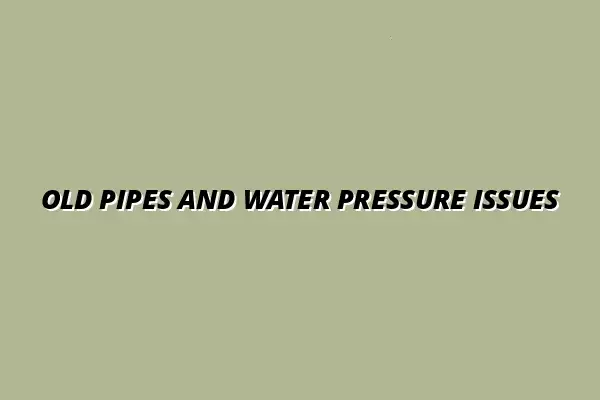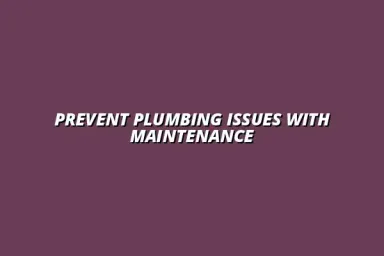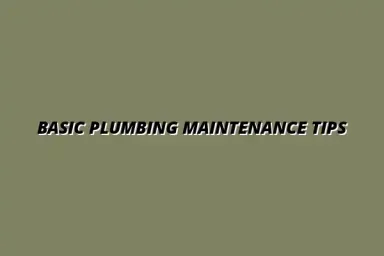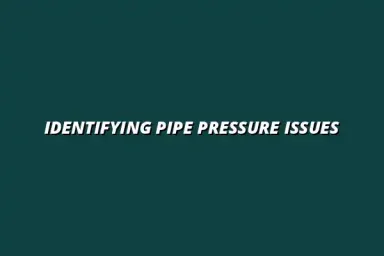Understanding Water Pressure Issues Related to Old Pipes
Water pressure is a crucial element in how our plumbing systems operate. It determines how effectively water flows through pipes, affecting everything from your morning shower to washing dishes. A proper understanding of water pressure and its implications can help homeowners diagnose and resolve plumbing problems related to aging pipes.
Defining Water Pressure and Its Importance in Plumbing Systems
Water pressure is the force that pushes water through pipes in your home. It is measured in pounds per square inch (PSI), and maintaining the right level is essential for optimal home functionality. When water pressure is too high or too low, it can lead to various plumbing issues that can be both annoying and costly.
What Constitutes Healthy Water Pressure?
Healthy water pressure typically ranges from 40 PSI to 60 PSI. Anything below 40 PSI may lead to weak water flow, while above 60 PSI can cause stress on your plumbing fixtures. Regular checks on your water pressure can help you ensure your plumbing operates smoothly and effectively. For tips on fixing low water pressure, check out this helpful guide: Fix Low Water Pressure Easily.
The Role of Water Pressure in Daily Activities
Water pressure affects many daily tasks, such as showering, washing clothes, and cooking. When the pressure is too low, these activities can become frustrating. Imagine waiting for your shower to warm up or struggling to fill a pot for pasta! Ensuring a healthy water pressure can enhance your overall convenience at home.
Identifying Old Pipes and Their Common Characteristics
Aging pipes can significantly impact water pressure, leading to various plumbing issues. It's essential to identify the signs of old pipes before serious problems arise. Common characteristics include discoloration, leaks, and unusual sounds when water runs through them. Learning how to detect hidden pipe leaks at home is a crucial skill for homeowners.
Materials Used in Old Pipes: Lead, Galvanized Steel, and More
Older homes often have plumbing made from materials like lead, galvanized steel, or cast iron. These materials can corrode over time, affecting water flow and quality. Here are some common materials found in old pipes:
- Lead
- Galvanized Steel
- Cast Iron
- Polybutylene
Age and Wear: How Time Affects Pipe Integrity
As pipes age, they may experience wear and tear that compromises their integrity. Factors like soil conditions and water quality can accelerate this deterioration. Regular monitoring can help catch problems early before they escalate into more significant issues. Regular maintenance, as described in this article on preventative plumbing maintenance, can significantly extend the lifespan of your pipes and reduce the likelihood of costly repairs.
Common Water Pressure Problems Caused by Aging Pipes
Aging pipes can cause several water pressure problems that can be both challenging to identify and expensive to fix. Understanding these issues can help you take timely action. Some common problems include:
- Corrosion
- Mineral buildup
- Pipe leaks
Corrosion and Its Impact on Water Flow
Corrosion is a natural process that occurs as pipes age, leading to rust buildup. This can restrict water flow, resulting in low water pressure. If you notice brownish water or rusted fixtures, it may indicate corrosion within your plumbing system.
Mineral Buildup: The Effect of Hard Water on Pipe Performance
Hard water can lead to mineral deposits building up inside pipes over time. This buildup can narrow the pipes, reducing water flow and pressure. If you live in an area with hard water, consider using a water softener to help mitigate these issues. Regular water heater inspections can also help identify and address mineral buildup issues early.
Pipe Leaks: How They Relate to Low Water Pressure
Leaks in aging pipes can significantly drop water pressure. When water escapes through cracks or holes, it reduces the amount available to flow through your faucets and fixtures. Keep an eye out for wet spots or mold, which can indicate a leak that needs urgent attention. Repairing a leaky kitchen sink, as described here, is a common plumbing repair that can prevent more significant issues.
How Aging Pipes Compromise Water Pressure
Aging pipes can lead to compromised water pressure through various mechanisms. It's essential to understand how these issues develop so you can address them effectively. Here are a couple of ways aging pipes can impact pressure:
- Blockages
- Pipe size restrictions
Understanding Blockages and Their Origins in Old Plumbing
Blockages in older plumbing often arise from corrosion, mineral buildup, or debris. Such blockages can significantly reduce water flow and pressure. Regular inspections can help identify and clear these blockages before they become major problems. Understanding the causes of bursting water pipes can also help prevent future issues.
Pressure Loss Due to Pipe Size Restrictions and Damage
Old pipes may have smaller diameters due to wear, which can restrict water flow. Damage, such as cracks or holes, can also cause pressure loss. Regular maintenance and timely upgrades can help maintain optimal water pressure in your home.
Diagnosing Water Pressure Problems Linked to Old Pipes
Identifying water pressure issues linked to old pipes involves recognizing specific signs and understanding when to call for help. It's crucial to pay attention to your plumbing system to catch these problems early.
Signs That Point to Aging Pipes in Your Home
Some common signs that indicate you may have aging pipes include:
- Low water pressure
- Discolored water
- Unusual noises from pipes
- Frequent leaks
When to Seek Professional Help for Water Pressure Issues
If you notice any of the signs mentioned above, it may be time to call in a professional. An expert can perform a thorough inspection and help diagnose the problem accurately. Don't wait until minor issues escalate into a plumbing disaster—seek help early! For reliable plumbing services in Birmingham, consider contacting a plumber in Billesley, Birmingham.
Addressing Water Pressure Problems from Old Pipes
Dealing with water pressure issues related to old pipes is crucial for ensuring that your plumbing system works effectively. Addressing these problems can seem daunting, but with the right knowledge and tools, homeowners can take control of their plumbing health. Here, I’ll share preventive measures and repair options that can help maintain optimal water pressure in your home.
Being proactive about your plumbing not only improves water pressure but also saves you from costly repairs down the line. Let’s dive into some key strategies to tackle these issues!
Preventive Measures to Maintain Optimal Water Pressure
Maintaining good water pressure starts with regular maintenance and preventive care. By being attentive to your plumbing, you can catch potential issues before they escalate. Here are some effective preventive measures to consider:
- Regular pipe inspections: Check for leaks, corrosion, and signs of wear.
- Flush your system: Periodically flush your pipes to clear out any buildup.
- Monitor water pressure: Use a pressure gauge to ensure it stays within the ideal range.
- Check your fixtures: Ensure faucets and showerheads are not clogged with mineral deposits.
Regular Pipe Inspections and Maintenance Practices
Consistent inspections play a huge role in maintaining water pressure. Schedule checks every few years, and pay attention to any changes in your plumbing system. During these inspections, look for:
- Cracks or leaks in exposed pipes
- Signs of rust or corrosion on metal pipes
- Unusual sounds, like banging or whistling, which may indicate pressure problems
By catching these issues early, you can take necessary actions to avoid bigger plumbing dilemmas!
Using Water Softeners to Reduce Mineral Buildup
If your home has hard water, installing a water softener can significantly improve your plumbing performance. Hard water contains minerals that deposit in pipes, leading to clogs and reduced water pressure. A water softener works by:
- Removing calcium and magnesium ions
- Preventing mineral buildup in plumbing systems
- Increasing the lifespan of appliances using water
Implementing these systems can help maintain optimal water pressure and enhance overall plumbing health.
Repair and Replacement Options for Aging Plumbing
When preventive measures aren’t enough, it may be time to consider repairing or replacing old pipes. Knowing the right course of action can save time and money, as well as improve water pressure significantly. Here’s how to approach this decision:
Start by assessing the condition of your pipes. If they show signs of severe wear, replacement may be the more effective option. Here are some pointers to keep in mind:
- Evaluate the extent of damage
- Consider the age of the plumbing system
- Look for consistent issues like leaks or low pressure
Understanding When to Repair vs. Replace Old Pipes
Deciding whether to repair or replace old plumbing can be tricky. Here are some guidelines to help you make that choice:
- If only a small section of piping is damaged, a repair may suffice.
- For widespread issues or frequent repairs, upgrading to new pipes is likely a better investment.
- Consider the long-term costs of repairs versus the initial expense of replacement.
Making the right choice can lead to better water pressure and peace of mind!
Modern Pipe Materials: Advantages Over Traditional Options
When it comes to replacing old pipes, you have several modern materials to choose from. These newer options offer advantages over traditional materials like galvanized steel and lead:
- PVC: Lightweight, resistant to corrosion, and easy to install.
- CPVC: Can handle higher temperatures and pressures, ideal for hot water systems.
- Pex: Flexible, which makes it easy to navigate tight spaces and reduces the need for fittings.
Choosing modern materials can boost your plumbing system's efficiency and help maintain better water pressure.
FAQs About Water Pressure and Old Pipes
It’s common to have questions about water pressure issues related to old pipes. Understanding these queries can help clarify solutions and steps you can take. Here are some frequently asked questions:
What Are the Most Common Signs of Low Water Pressure?
Low water pressure can manifest in several ways. Recognizing these signs early can help you address the problem promptly:
- Weak or slow water flow from faucets
- Inconsistent water pressure when using multiple fixtures simultaneously
- Strange noises in the plumbing system, like whistling or banging
If you notice any of these symptoms, it might be time to investigate further!
Can I Fix Water Pressure Problems Caused by Old Pipes Myself?
While some minor adjustments can be handled independently, larger issues often require professional assistance. Here are some DIY fixes to try:
- Cleaning showerheads and faucet aerators to remove mineral deposits.
- Checking and adjusting your pressure regulator if you have one.
- Inspecting exposed pipes for visible leaks.
However, for significant repairs or replacements, hiring a qualified plumber is the best option!
Final Thoughts on Managing Water Pressure Issues in Older Homes
In summary, addressing water pressure problems from old pipes is vital for maintaining a healthy plumbing system. Preventive measures, timely repairs, and modern materials can all contribute to better water pressure in your home. Remember, keeping an eye on your plumbing can save you from headaches down the line!
Summary of Key Insights on Old Pipes and Water Pressure
Old pipes can lead to numerous water pressure issues, but being proactive can make a huge difference. Regular inspections, using water softeners, and knowing when to repair or replace pipes are key actions to take. By understanding these elements, you can take charge of your plumbing health.
Encouraging Homeowners to Take Action for Better Plumbing Health
Finally, don't wait for water pressure issues to worsen! Take action now to ensure that your plumbing system remains in great shape. Whether it’s scheduling an inspection or considering upgrades, every step counts toward maintaining better water pressure and a healthier home!

 Kiran Almasi
Kiran Almasi

